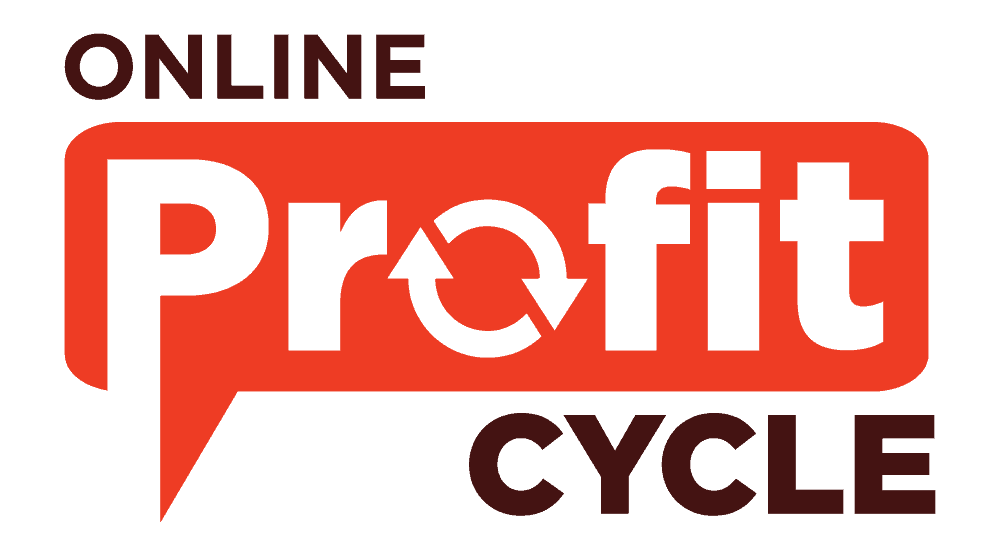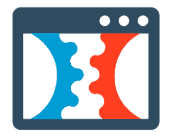Sales Funnels Explained For Beginners: Full Guide
If you’re an entrepreneur or in the digital marketing space, you might have heard of funnels, sales funnels, or marketing funnels. The word funnel has become a known term all over the world because it’s a very effective way of selling products online. But what exactly is a funnel and how does it work?
A sales funnel is used to generate leads, applications, and sales online. Each sales funnel consists of multiple web pages and work like an automated sales process. Sales funnels are often used by businesses, entrepreneurs, and digital marketers to grow, scale and run their businesses online.
Did you know that funnels are considered the future of websites? That’s because with funnels you can increase the overall cart value of every customer and decrease your operating costs. The dream scenario for every business owner, right?
Disclaimer: This article may contain affiliate links where I receive a small commission at no extra cost to you if you decide to purchase a paid plan. For more information read my Disclosure.
What Is A Sales Funnel?
If you’re wondering what a sales funnel is, simply imagine a real-world funnel which is wide at the top and narrow at the bottom. At the top of that funnel, some substance is poured in, which filters down towards one finite destination. In sales, something similar occurs. At the top, lots of visitors arrive who may enter your funnel. However, unlike the real-world funnel, not all who enter the sales funnel will reemerge out from the other end.
Down below you can see a simplified illustration of how a sales funnel works. People come into your funnel, then they go through the sales process and some end up as paying customers.
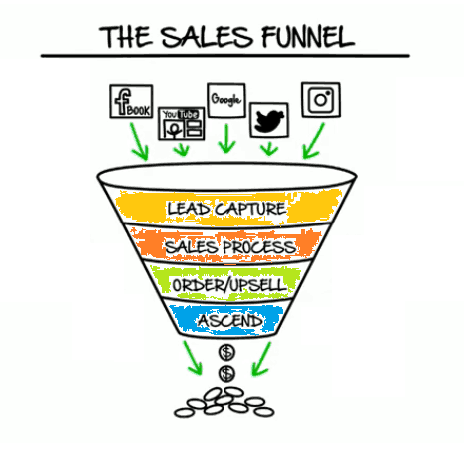
The picture above is a very simplified overview of a sales funnel. Here’s how it works: You start generating traffic from either social media, search engines, or ads. When people interact with your content and click on a call to action (CTA) they end up at some sort of landing page, which is the first step in the sales funnel process. These visitors becomes prospects. The first page of your funnel (landing page), can either be used to generate leads or start pitching you product. In most cases you would want to have a lead capture from on the landing page, to build an email list. Then you have the ability to sell them products in the future.
After your prospects have become leads, they will go to the next step in the funnel, which is a sales page. As the image above illustrates, the funnel becomes more and more narrow further down. That’s because some people will say ”no thank you” to your offer, while others ends up purchasing your product or service.
The people that makes it all the way through the funnel, becomes your paying customers. Each of them have completed various steps, and are now fully emerged into your product or service. At this point they’ll know who you are, which will make it much easier to sell them products in the future.
Sales Funnel Examples
A funnel is designed to guide your visitors step-by-step through the entire sales process (so they don’t get confused or LOST, and leave). This is what makes sales funnels so great: They’re very simple, and each of the funnel steps serves a purpose, to increase the conversion rate.
Above you saw a very simplified picture of what a sales funnel looks like, so it would be easier to understand how they work. Now we’re going to go one step further. This is a real example of a sales funnel.
Down below you can see the outline of a sales funnel. This spescific sales funnel is called a 2-step Tripwire Funnel. It’s used for running a ‘Free + Shipping’ offer to sell books, reports or case studies. The goal of this funnel isn’t to make money upfront, but at the back-end. Let me explain how it works.
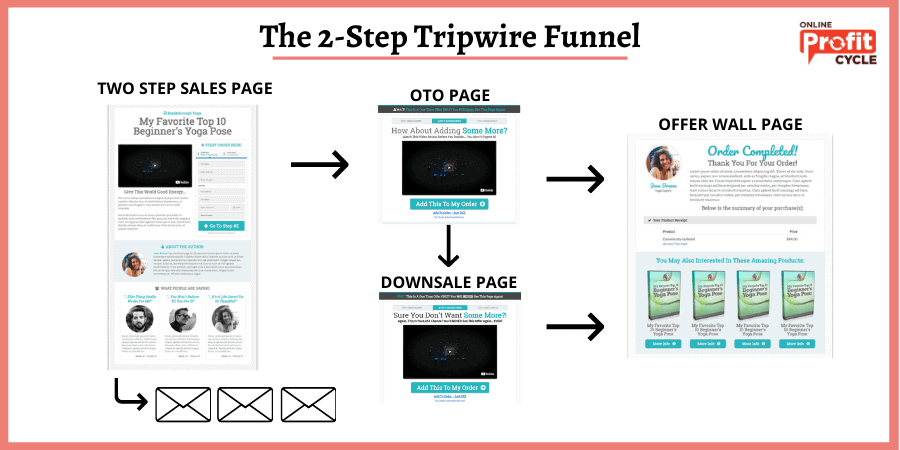
A Tripwire is a low ticket front end product that is so irresistible people have to purchase it. After they put in their credit card, you can then upsell them your more expensive products through Order Form Bumps and One Click Upsells or Downsales.
The ‘Two-Step’ gets its name from the Two-Step Order Form used on the first page of this funnel-type. During Step One, a potential customer is asked for and submits their contact information. During Step Two, the potential customer selects their product and enters their credit card information. The real power of the two-step comes from the ability to follow-up with a potential customer if they didn’t complete Step Two.
Upsells and Downsells follow the first page to increase the Average Cart Value. Typically, the goal of this funnel is to breakeven on ad-spend, then ascend paying customers to higher-ticket offers on the Thank You Page. This sales formula follows the concept of the Value Ladder teached in the book DotComSecrets.
Although every sales funnel is different, they have some common features. The ability to increase the overall cart value is one of them. If you have a business and sell products online, this should be exciting news. Next up is the 7 phases in a funnel and the strategy that makes them so profitable.
The 7 Phases of A Sales Funnel: The Strategy
The reason it’s called a funnel is because the whole sales process is divided into several steps. Each of the 7 phases below represent a stage in the funnel. These are the fundamentals of each sales funnel. If you learn how these phases work, you know the magic and strategy behind a successful sales funnel.
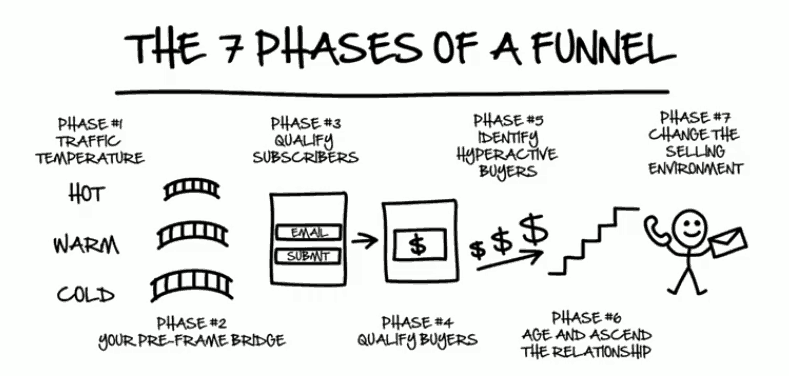
Phase #1 – Traffic Temperature
When you sell something online you always start with the traffc, but did you know there are different types of traffic? You need to speak different to people depending on who they are. It’s very important that you get this step right if you want to succeed online. The warmer your traffic is, the better, but what exactly is the difference between the types of traffic?
- Hot traffic: Hot traffic is the best traffic you can generate, they’re aware of who you are and the product you’re selling. They like you, and because of that they’re most likely to buy your stuff. Hot traffic can be previously customers of yours or be on your email list.
- Warm traffic: These are people who are in your industry, but they don’t know you yet. They might have a problem that you can solve with your product or service. All you need to do is to get infront of their eyes, and present your offer. You might target your warm audience with Facebook or Google ads.
- Cold traffic: These are people who don’t know who you are and they’re not in your industry. This is the hardest type of traffic to convert into customers. Normally I would avoid spending too much money trying get cold traffic into my funnels.
When you’re building an entrance-point for your funnel, you need to adapt it to your traffic temperature. Are you building it for a hot audience that knows who you are, or a cold audience that’s not in your industry? It makes a lot of sense if you think about it.
Phase #2 – Your Pre-Frame Bridge
The pre-frame bridge happens before your traffic enters your funnel. Here’s your goal to pre-frame/pre-sell your offer, so that the visitor knows what to expect. It’s also to get you traffic into the right mindset before entering your funnel.
Example: You drive traffic from two different Facebook ads. In the first ad you say ”I joined this program and it was a scam, I lost all my money. The owners don’t care about their students and nobody has every succeeded. Click here and join the program now.” In the second ad you say ”I joined this program and it doubled my income, the owners are great because they guided me step-by-step through the process. I highly recommend you take a look at it. Click here to join.”
You might get traffic from both ads, but which of them do you think will send you your future customers? My bet is the people that comes from ad number two. The pre-frame bridge is important when you’re generating traffic to your funnels.
Phase #3 – Qualify Subscribers
When you’ve found the right traffic and created the perfect pre-frame bridge, the traffic will start coming into your funnel. Now we need to qualify subscribers.
It’s very common (and smart) to send you traffic to a landing page where you can capture user information like email addresses, phone numbers etc. Then you’ll have the opportunity to add them to your email list and find out who is willing to trade their email address in exchange for information. Because some people will never give you their email, and those people will most likely never buy from you either.
Phase #4 – Qualify Buyers
The people that gave you their email address, will be sent to the next step in the funnel. Here you’re going to qualify the buyers. Then you’ll find out who is actually willing to buy something from you. This is the funnel step where you create customers.
If someone has bought from you before, they’ll keep buying until you either stop selling to them or offend them.
As you go further into the funnel, less and less people will stick. That’s the beauty of the sales funnel design. When someone goes all the way through, you know they’re a part of your dream audience and they most likely love what you have to offer. Then it will be easier to sell them something in the future.
Phase #5 – Identify Hyperactive Buyers
The next step in the sales funnel process is to identify the hyperactive buyers, but what’s that? Hyperactive buyers are people who purchase several things at once. Example: You go to the store to buy a specific product, but on your way out you find more products that you end up buying. Thats a hyperactive buyer.
This part of the funnel is where you have the One Time Offers, Upsells and Downsells with products related to your main offer. Hyperactive buyers will then use this opportunity to buy more of your products. Meaning your profits will rise.
This phase is also the end of the actual funnel. After your customers have been through the upsale and downsale pages, it’s normal to send them to a thank you page where they can get the products they bought. Even though the sales funnel ends here, there are still some steps left in the entire sales process.
Phase #6 Age and Ascend The Relationship
In this phase your goal is to age and ascend the relationship with your customers. If you’ve read the book DotComSecrets, you’re familiar with the value ladder. The concept behind the value ladder is to promote more expensive products to people who have already bought something from you.
Example: The first funnel you send people through, you sell a cheap book. The people who buys the book, becomes your customers who have shown interest in what you have to offer. This is step one in the value ladder. The next step might be a bit more expensive course that you’ve made on the topic. The step after that could be a live event or a workshop, for your real hardcore followers.
How do you age and ascend the relationship? You simply add value to your audience. The fact that you’ve already sold them something, means that they know who you are and they like your product. If you keep delivering valuable content, they’re more likely to buy from you in the future.
Phase #7 – Change The Selling Environment
This phase is all about changing the selling environment, which means going offline. This doesn’t relate to everybody, but if you have a business where you interact with people offline, then it would be helpful. By changing the selling environment you have an unique opportunity to connect with your audience on a whole new level. This can be done in live events, work shops, meetings etc.
Recap: There you have the unique strategy to convert traffic into leads, then leads into customers by using a sales funnel. This strategy can be used in every business model on the planet. These are the main phasess of every sales funnel. Not only will it help you increase the overall cart value of every person that goes through your funnel, but it will also massively dicrease your operation costs.
If you want to know how this exact funnel strategy has helped businesses grow from ‘startup’ to ‘million dollar companies’ in just months, then watch this FREE presentation of the Secret Funnel Startegy by Russell Brunson.
Sales Funnel vs Website: What’s The Difference?
What is the difference between a website and a funnel, aren’t they the same? you might ask. Well, there is actually a huge difference between the two. By now you should have a pretty good understanding of what a sales funnel is and how it works, but do you know why it stands out from a traditional website? Keep reading to find out…
The Traditional Website
Have you ever heard the saying, ”a confused mind will always say no”, that’s the first rule in direct respond marketing. Why is that important? If you send traffic to a landing page (website or funnel), the last thing you want, is for them to leave right away. That’s not a good business model. Simplicity is they key to success online!
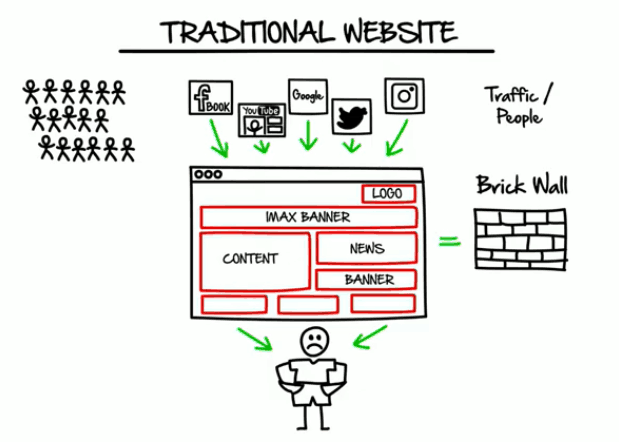
This is what a traditional website looks like. If you have one yourself, nice. The website might look good, but does it serve the right purpose? Do you make any money with it?
If you drive traffic with Facebook or Google ads, and send the traffic to a landing page like this, chances are that they’re going to leave. But why? Because there are so many call to actions, that it confuses the visitor. It’s like slamming a bunch of people into a brick wall.
Traditional websites often have around 30 – 100 Call To Actions on the page, including the menu, sidebar and footer. Imagine you go to a store and the second you walk in the door, there are 100 salesmen trying to sell you different products. If that has happened to me I would walk straight out. That’s what a traditional website do to your business, it’s a dying model.
The Sales Funnel
The sales funnel is the evolution of the traditional website. It’s the future of running your business online. Why do sales funnels work so well? One word, simplicity. They’re designed to take you visitors on a customer journey, where it’s much more likely that they end up buying your product.
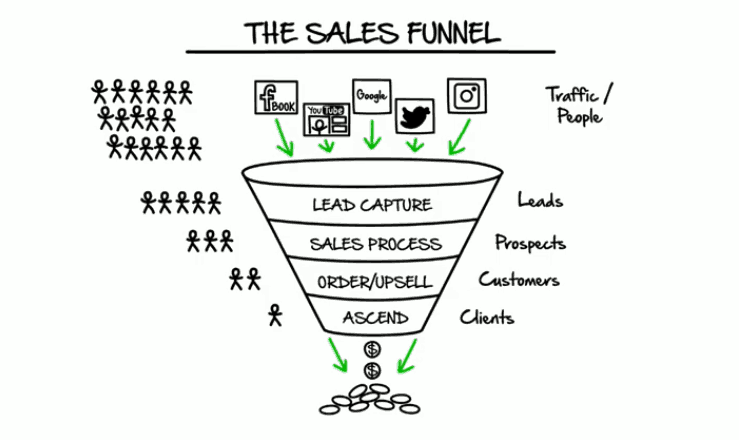
This is what a sales funnel looks like. Instead of slamming your visitors into a brick wall, you send them into an userfriendly sales process. A funnel is designed convert traffic into customers. As you can see on the image above, the sales funnel is selecting out your true customers. Here’s how it works.
You send your traffic to a simple optin page, where the only thing they can do is to type in their email address. This way they won’t get confused and leave. After that, your visitors (now leads) are sent to a sales page where you sell them your product or service. When they’ve purchased your offer, the next funnel step is an One Time Offer Page. On the OTO page you offer them a deal thats only available for a limited time. If they say YES, they go to a thank you page. If they say NO, they will be sent to a Downsell page. Here you offer them a related and cheaper product. This is the end of the actual sale funnel, but the sales process keeps going. Now you can follow up with your leads and customers via email marketing.
If you ask me, I think this is a much better way of selling products online than using a traditional website. Sales funnels are built for entrepreneurs and business owners like me and you.
Conclusion
The key difference: Funnels minimizes distractions, and each page highlights what the company has to offer and prompts the visitor to take action… or leave. The best part: sales funnels are proven to result in higher sales conversions. Traditional websites does more harm than good for your business.
The Four Types of Sales Funnels
By now you’ve learned a lot about funnels, you know what it is, you know how they work, and you know the difference between a website and a sales funnel. But did you know there are several types of funnels?
There are 22 types of funnels that cover almost every possible situation for almost any type of business or industry! You could tweak these funnels by adding presale pages, or adding more upsells, etc… but the framework of these 22 are the foundation of all good funnels. These funnels are broken into four types:

- Lead Funnels: These funnels are specifically for generating leads, applications, and contact information from your future customers.
- Buyer Funnels (Sales Funnels): These funnels are structured in a way to get someone to actually pay you inside of the funnel. They have integrated shopping carts, one click upsells, downsales and more.
- Event Funnels: These funnels are for hosting events like webinars, automated webinars, workshops, etc.
- Other Funnels: There are other funnels that are useful that don’t really fit into any of the situations above. They are included here inside of other funnels.
Each of these funnel types have multiple variants you can choose from. This is obviously just a small portion of every funnel you can use in your business. But whatever goals you have, there is a funnel to fulfill them. If you want to know more about the 22 types of funnels and how to use them in your specific business, grab a free version of the Funnel Hackers Cookbook here. If you aren’t sure if your business need a funnel or not, then keep reading.
Does Your Business Need A Sales Funnel?
For some reason, some people think that their business is different and that funnels may not work for them. The reality is that funnels work for any type of business that is trying to generate leads or create customers.
Using funnels in your business is like having the best sales person on planet earth to close your sales for you 24/7, and never complains, ask for a raise, or takes a break.
I have a question for you: Who do you think is the best person to sell your product or service? My guess is that it’s probably you or someone on your team. Because, who cares more about the product you’re selling and the success of your company than you, right?
With funnels you’re able to leverage the best sales person in your company (you or someone on your team), to record a video with the best sales pitch for your product or service. Then plug the video into your funnel, and let it close sales for you on autopilot 24/7. The best part about all of this, is that you only need to do it once.
As you might know sales people can be great to have on your team, but they also have bad days. Their performance will vary. With an automated funnel you can record the perfect sales video once, and your traffic will hear the exact same sales pitch every time they go through your funnel. That’s like having the best sales person in your company closing deals 24/7, and he/she never complains, asks for a raise, or takes a break.
I went from having 60 full time sales people down to one, and it’s not even a person, it’s a funnel.
Russell Brunson, CEO and founder of ClickFunnels
I hope you see the power of funnels, because they can completely revolutionize your business. so, do your business need a funnel? The answer is YES. If you’re planning to promote and sell your products or service online, then funnels are the way to go.
Obviously, every funnel isn’t going to be right for every business. Example: Affiliate marketers have different goals than Real Estate agents, but the core funnel strategy still stays the same. Here’s a list of every business that should use funnels to generate leads and sales:
- Authors, Speakers, Coaches, Consultants: These are people who are selling information products, books, masterminds, coaching, consulting, live events, and more. While these industries are different, the types of funnel they use and how they use them are very similar.
- Professional Services: There are a lot of different types of professional services. This would include businesses like chiropractors, real estate agents, dentists, CPAs, financial and insurance agents and more.
- Retail: Retail would include restaurants, gyms, spas, salons, entertainment, auto shops and more.
- Ecommerce: Ecommerce are physical products such as those typically sold on Amazon, Shopify, Etsy, eBay, and other online stores.
- Network and Affiliate Marketing: These are people selling other people’s products, so it could include distributors, affiliates, people doing home parties, direct sales, etc.
- Business To Business (B2B): The last category is B2B. This is anyone selling any type of product or service, consulting, equipment, or more from one business to another.
If you’re doing business in one of the industries above, then you should be using a funnel. Now you might be thinking, OK, I need to use funnels in my business, but how do I create them and how much does it cost?
Let’s move into the fun part, funnel building.
How To Build High Converting Sales Funnels
Many entrepreneurs, business owners and digital marketers have false beliefs about funnels. They think it’s hard to build a sales funnel and that it costs a fortune. But it’s easier than you think.
The first (and only) thing you need to build high converting sales funnels for your business, is a funnel builder software. I highly recommend you use ClickFunnels to do the job. It’s a software that allows you to create simple and modern funnels, without any coding. ClickFunnels also have multiple pre-made sales funnels that you can use in your business for FREE.
Clickfunnels isn’t just a funnel building software, it’s an amazing community where you can find likeminded entrepreneurs that have done what you want to achieve with your business. By using ClickFunnels in your business you also have the chance to become a part of the Two Comma Club, which is an exclusive club for Clickfunnels members that have generated over $1,000,000 inside a single sales funnel.
1. Choose Your Funnel Building Software
ClickFunnels is the tool created to free all entrepreneurs from overpriced web-designers and lazy salesmen. With an easy-to-use page builder (so simple that you can do it all by yourself) you have the ability to create high converting sales funnels in the matter of minutes.
You might recognize some of the entrepreneurs that uses Clickfunnels on a daily basis. People like Grant Cardone, Dan Lok, Tony Robbins, Kevin David, Dean Graziosi, Tai Lopez and Anthony Morrison, uses Clickfunnels to sell their products and service online. Imagine meeting them at one of Clickfunnels’ live events (Funnel Hacking Live).
To get started using the software everyone talks about, you simply just need to unlock your 14 Day Free Trial in ClickFunnels. Go here to signup: https://www.clickfunnels.com. It takes less than ten minutes.
After you’ve created your free account, you can start playing around and learn all the features Clickfunnels has to offer.
2. Make Sure You Succeed With Sales Funnels
It’s rare that the first sales funnel you build becomes an huge success. In most cases you’ll have to test and try different things to figure out what work best for your business. Although Clickfunnels makes it super easy to build high converting sales funnels, there are some helpful tools that you should know about. These tools can help you achieve massive results. Here they are:
One Funnel Away Challenge. The One Funnel Away Challenge is a digital course created by Russell Brunson (Founder & CEO of Clickfunnels) and his team at Clickfunnels. In the course you’ll get the exact blueprint of a high converting sales funnel, the only thing you need to do is to customize it to your product and business. If you’re brand new to funnels, I highly recommend you join the challenge. It’s only $100 to enroll, and once you have you’ll get access to five weeks of intense training from the best funnel builders in the world. The One Funnel Away Challenge can absolutely reinforce and change your business forever if you follow the steps, which I believe you will. What are you waiting for? Click the link above and accept the challenge! Then we can move on to the next tool that will help you achieve massive results with funnels.
Funnel Scripts. If you have your own business, you know that selling is the most important part, it might also be the hardest part. When you’re doing business online, writing sales copy for email campaigns, ads, sales letters, etc. can be a pain in the ass. You may have hired a copywriter or an agency to do the job for you. With Funnel Scripts you can save both time and money. It’s a software that does all the copywriting for you! The only thing you need to do is to type in some basic information about your business and the product or service you’re selling. Then, within a few minutes Funnel Scripts gives you the best sales copy and scripts to use in email campaigns, ads, sales letters etc. That’s how you get all of your sales copies written (in less than 10 minutes) without hiring an expensive copywriter. Saving you time, money and irritating headaches.
Funnel Scripts: Click here to watch a free demo of how the copywriting software works.
If you struggle to write good copy for your business (or if you’re like me and just don’t have the time, or don’t WANT to do it), then this free training is going to be an eye-opener for you!
DotComSecrets. I’ve mentioned this book a couple of times in the article, that’s because it’s one of the best ways to learn about funnel. DotComSecrets is written by ClickFunnels CEO Russell Brunson and it will show you a simple process that ANY company can use to geometrically improve their traffic, conversion and sales online. This book is the gateway to understanding the concept of funnels. Click the here to claim your free copy of DotComSecrets, and boost your entrepreneurial skills today.
Summary
Congrats, you’ve made it through the article, or did you just scroll to the bottom? Anyways, if you read it all, you now have the basic funnel knowledge in place. How you want to use it is up to you. My advice: Take Action. Don’t wait until the perfect moment to start building sales funnels for your business, because that’s not going to come. Remember, you’re just one funnel away from massive success.
Here’s a quick recap for those of you who skipped the article and scrolled to the bottom: Funnels are the best way to generate sales and leads online. A sales funnel consists of several steps, where your visitors need to go through in order to become your customer. This way you’re able to increase your overall cart value, because some of the steps includes Upsells and Downsells. Funnels works for every business and industry that generates leads and sales. To create your own funnels I hihgly recommend using Clickfunnels to do the job. It’s a software that has an easy-to-use page builder, which allows you to create high converting funnels in the matter of minutes.
